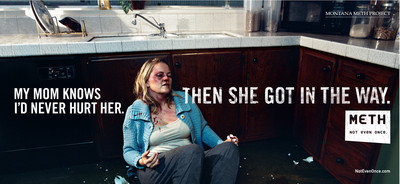METH PROJECT
WASHINGTON -- A "scared straight" style of advertising campaign that presents uncomfortable and sometimes shocking portrayals of methamphetamine use is being reviewed by Nevada leaders after it has been credited for reducing drug use dramatically in Montana.
One print ad displays a middle-aged woman sitting on a kitchen floor, bleeding and bruised. "My mom knows I'd never hurt her. Then she got in the way," the copy reads in bold lettering.
Another shows a dirty, trash-covered toilet stall. "No one thinks they'll lose their virginity here," the copy reads. "Meth will change that."
On television, a 30 second ad shows a teenage girl wearing little clothing and covered in open sores, hunched over on a bed, moments after her boyfriend has pimped her to an older man for meth.
The campaign originated in Montana in 2005, funded by billionaire businessman Tom Seibel. With studies suggesting the ads have been effective, Seibel's organization, the Meth Project, is exporting it to other states.
Nitsa Zuppas, Meth Project executive director, said officials have held discussions with Nevada Attorney General Catherine Cortez Masto.
"It was a high level discussion about the program, the issues in Nevada and how The Meth Project might address the problem in other states," Zuppas said.
Nicole Moon, a spokeswoman for the attorney general's office, confirmed that Masto had spoken to Zuppas.
"(Zuppas) sent us a proposal for a meth working group and it is one of the things we are looking at," Moon said.
Masto is chairwoman of the state Working Group on Methamphetamine, formed by Gov. Jim Gibbons. The group is studying the possible state responses to the meth problem.
"Nevada is still kind of new to the meth issue, and the attorney general will not be submitting her final report on methamphetamine to the governor until Dec. 31," Moon said.
A 2006 National Survey on Drug Use and Health found Nevada had the highest percentage of respondents reporting they used meth in the last year, at 2 percent.
Meth use among young adults from 18 to 25 was 3.8 percent.
The Meth Project delivers uncomfortable and controversial messages that are placed in both traditional media and online. They can be found at www.notevenonce.com.
The ads have carpeted Montana, scheduled in six week "pulses," Zuppas said. Over the two-year program there were more than 91,000 ad placements in TV, radio, print and billboards, along with promotions of the Internet site.
On television the graphic commercials run from 7 p.m. to midnight, in an attempt to shield youngsters, Zuppas said.
Jeff Shay, a professor and chairman of the marketing and management department at the University of Montana, said the gritty nature of the ads is what made them work.
"When I first saw them it reminded me of when I was in drivers (education) and they showed us the drunk driving videos -- those still stick with me," Shay said.
Shay said that as a teacher of an entrepreneurship course he found the campaign particularly appealing because it parlayed Seibel's investment into a social good.
"It is encouraging that a successful entrepreneur could pursue a social problem with the same vigor as he pursues moneymaking opportunities," he said.
The effort was financed by the private sector at a cost of more than $15 million, including Seibel's contributions.
The campaign has won numerous advertising awards, and the White House has selected 14 states to get federal money to adopt the Meth Project ads, including California, Utah, Wyoming and Oregon. Nevada was not one of the 14.
Arizona is running the campaign now with state funding. Idaho has raised private money to initiate the program. Illinois is expected to start running ads early next year.
Costs vary by state, Zuppas said.
"What the states do is leverage the campaign, they don't pay for the development (of the ads)," she said. "We pay for the development, the states pay for the individual ad placements."
On Capitol Hill last month, Montana's lawmakers credited a statewide effort for the decline in meth use.
Besides the ad campaign, they complimented crackdowns by state and local police, and implementation of the federal law that requires retailers to secure common cold and allergy medications used to create meth.
Testifying before the Senate Finance Committee that day, Seibel said Montana had dropped from 5th to 39th in the nation in meth use in the last two years.
Seibel called for the government to get behind the program.
"I respectfully submit the people of the United States would be well served if the U.S. Congress would consider providing funding to extend the Meth Project to other states," he said.




















